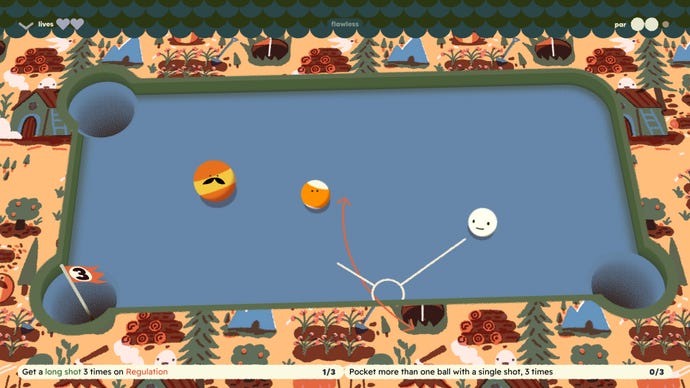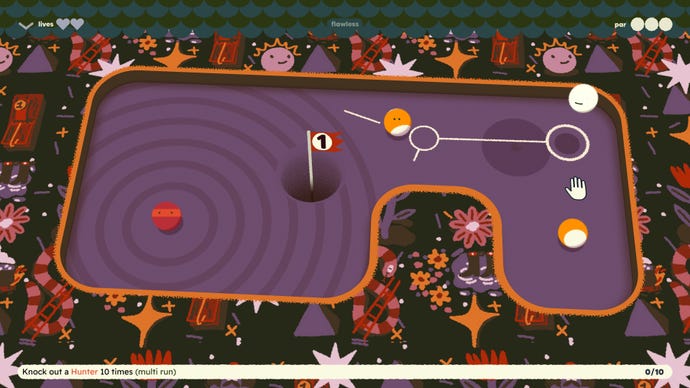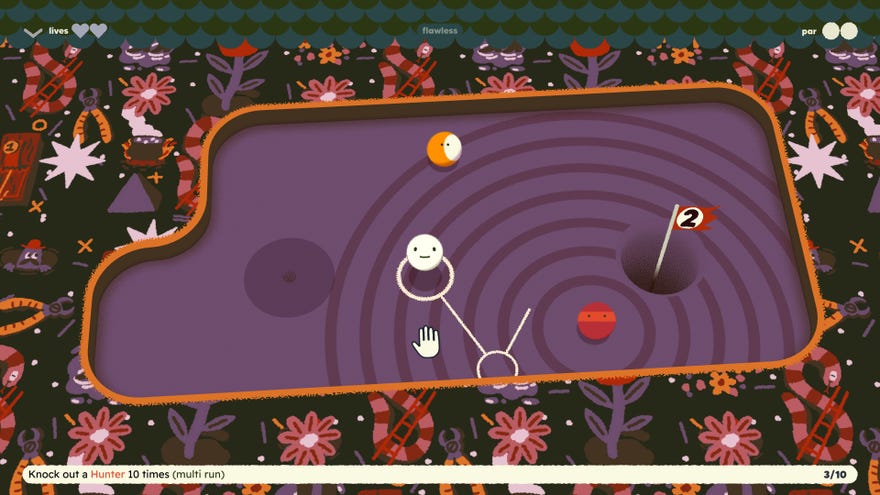Subpar Pool review: the most charming pool-golf you'll ever play, but not quite a hole(down) in one
Missed cue
As Rare famously discovered back in the 90s, if you stick a pair of eyes on an inanimate object, it immediately becomes the most adorable thing you've ever seen in your life. Take Subpar Pool's cue ball. What could have been just a straightforward mash-up of pool meets golf is suddenly given a new lease of life, warmth, charm and character, just because it has little eyes and a dumb, goofy smile plastered on its face. Some of its 'Chonker'-sized pool balls even have coiffed miniature moustaches for crying out loud, and they all babble cute nonsense noises at you as you ping them around its procedurally generated boards; hrnnnnngh they're just so gosh darn endearing that I simply cannot help myself. They make Subpar Pool a very easy game to like, which is precisely why it's so heartbreaking I can't quite bring myself to love it in the same way I do Grapefrukt Games' previous puzzle game, Holedown.

Don't get me wrong. Subpar Pool is its own special blend of sporting delight. The basic setup is thus: you pick a course of five proc-gen pool tables, and you must pocket the handful of balls to par (or sub par, if you're on a roll). Bogeys are the lowest score you can scrape by with, but fail to pocket all the balls on the table and you'll earn yourself a Sloppy rating, resulting in the loss of one of your two hearts, and any missed balls appearing as ominous black obstacles you'll need to avoid at all costs on the next table. Lose all your hearts, and it's the end of the run. Rinse, repeat, enjoy.
It's a simple enough premise, and in its purest form, it's all executed with oodles of style and panache. You can place your cue ball anywhere you like to start with (and again, if you pocket the cue ball after landing a shot), and adjust the angle of your approach. Working out how best to abuse both the rounded edges of the balls themselves and those of the course boundaries so you can slice, potshot and backhand your way to sub par is just as engrossing as it was in Holedown.
But Subpar Pool isn't simply about completing lots of five-course runs over and over again. There are also challenges you must complete in the form of cards, and you'll need to select a crop of these cards before attempting another game. Some challenge cards are attached to the courses themselves, such as performing three Longshots in a single run on the standard Regulation board, or passing through six warp points on the Gateways map. Others emerge from different ball types. Hunter balls will home in on your gurning white cue ball, for example, while Crystal balls can shatter if struck multiple times, and you may have card challenges that involve smashing four Crystal balls in one run, say, or pocketing the Hunter ten times, but only after you've already pocketed another ball already in the same shot.
Subpar Pool is Steam Deck verified, but the aspect ratio is a little chaotic at times, with text frequently dropping off the edge of the screen and everything appearing a little bit bigger than it perhaps should be. Still, controlling your cue ball with the analogue sticks is just as lovely and precise as using your mouse on desktop, making this a very pleasing Steam Deck experience. Image credit: Rock Paper Shotgun/Grapefrukt Games
Other cards are just extra standalone rules, such as having a fixed start, or no bounce line, for example. There are also cards that give you more walls, more balls, or more space, while others let you do fast runs, long runs and endless runs. But you'll only unlock these later cards by completing the challenges already available to you, and you can have up to eight cards in play at any one time to formulate your own style of boards and sense of fun.
The result is a kind of choose-your-own-adventure pool-golf that gives you the freedom to pursue the courses and challenges you like, while also giving a gentle steer on what you can do to get more cards and variations. It grants you a lot more freeform than Holedown, and the ball cards in particular do make you think differently about how you can play a course to solve its particular puzzle rules. However, it also runs the risk of tedium setting in much faster if you keep missing your goals. There are only ever a few active challenges available at any one time, and they often remain in your course selection menu until you've successfully completed them, leaving you with little option but to keep hammering away at them if you're stuck. It also discouraged me from selecting the cards without any challenges attached to them, as they often just put more unnecessary obstacles in my way to completing the ones I was struggling to make progress on.

Most challenges are reasonably self-explanatory, but if you're less familiar with pool's specific terminology, it's not very good at explaining itself if you do happen to get a bit stuck. I spent over an hour trying to work out exactly what conditions I needed to perform a simple Longshot, for example, which ended up becoming a major roadblock in unlocking the next course type. Clicking the card in the selection screen did nothing, and there's no glossary in the settings menu, either - nothing to say how far away the ball needed to be from the hole, or indeed whether the flagpole on the card's artwork was related to it either (it isn't, by the way, as all course cards have flagpoles with numbers on them, it turns out, but given I didn't know what other course cards looked like at this point, that's how desperate I was getting). Resigned to the single opening course like this, everything started to get a little bit repetitive, and later, when I started seeing the same challenges cropping up multiple times on the same card types, runs started to blur together even further.
Technically, you can just go ahead and unlock everything in the settings menu if you'd rather avoid these kinds of frustrations, but for me at least, that rather deflates any impetus to keep playing Subpar Pool in the first place. Any sense of structure and challenge is instantly lost when you don't have anything to work towards anymore, so I'd recommend playing it as intended if you're keen on giving it a shot. There is certainly a lot to like here, but as time's gone on, I find myself less and less keen to come back to it. The pool tables are all a little too similar to feel truly different in longer game sessions, and the challenges themselves come just a little too slowly to make it feel fresh and exciting. The allure of the googly-eyed cue ball is strong, but for me, it pales in comparison to the soul-hooking stare of Holedown's hypnotic worm lad.









